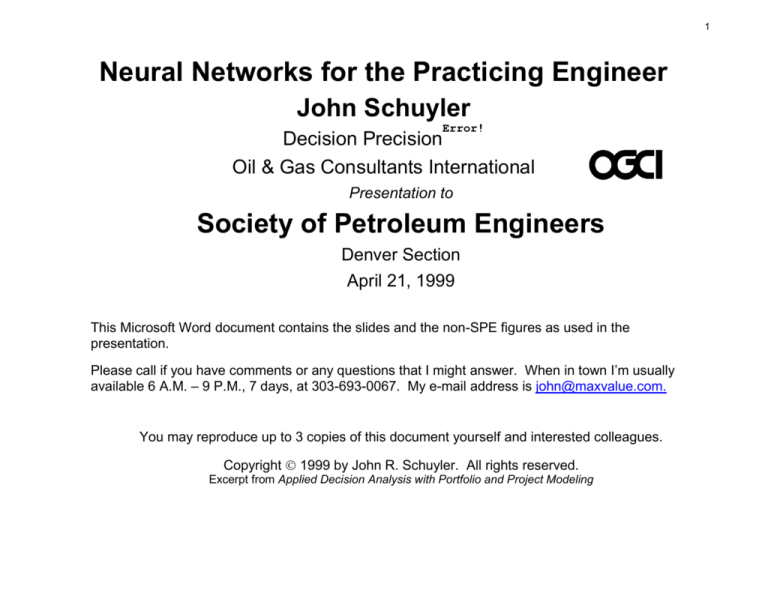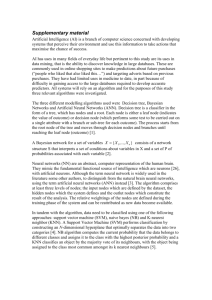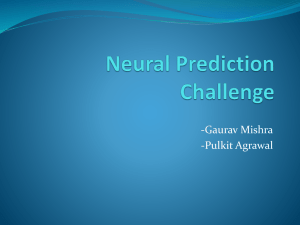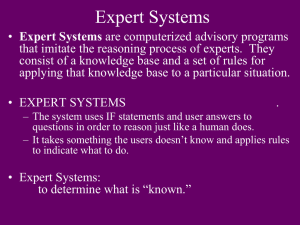
1
Neural Networks for the Practicing Engineer
John Schuyler
Error!
Decision Precision
Oil & Gas Consultants International
Presentation to
OGCI.WMF 7-28-93 in PD.pre
from OGCI1.TIF from Verma Hughes 7/28/93
Society of Petroleum Engineers
Denver Section
April 21, 1999
This Microsoft Word document contains the slides and the non-SPE figures as used in the
presentation.
Please call if you have comments or any questions that I might answer. When in town I’m usually
available 6 A.M. – 9 P.M., 7 days, at 303-693-0067. My e-mail address is john@maxvalue.com.
You may reproduce up to 3 copies of this document yourself and interested colleagues.
Copyright 1999 by John R. Schuyler. All rights reserved.
Excerpt from Applied Decision Analysis with Portfolio and Project Modeling
2
OUTLINE
Scope of Artificial Intelligence
Overview of Expert Systems
Overview of Neural Networks
Oilfield Applications of Neural Networks
Estimating PVT Properties
Predicting Bit Life
Forecasting Production
Est. Ultimate Recovery for New Wells
When to Consider Neural Networks
Getting Started and Guidelines
Wrap-Up
3
SCOPE OF ARTIFICIAL INTELLIGENCE
artificial intelligence
an engineering discipline devoted to designing ways
to make computers perform tasks that were previously
thought to require human intelligence.
4
The main subdivisions:
natural language processing
vision systems
robotics
expert systems (rule- and frame-based)
neural networks
Expert systems and neural networks are commonly
called
“knowledge systems”
5
OVERVIEW OF EXPERT SYSTEMS
expert system (ES)
a computer program that solves a particular
procedural problem in much the same way as would a
human expert.
The expert system allows a less-experienced person
to perform a task in a manner similar to and with
nearly the performance of a human expert.
6
Types of Problems Addressed
diagnosis and prescription
classification
planning and configuring.
MACSYMA system solves integral calculus.
Dipmeter Advisor for interpreting well logs.
Wine Advisor represents wine-choosing expertise of
an expert.
7
Example Expert Systems in Petroleum Industry
Interpreting logs
Diagnosing and prescribing remedies for stuck
drillpipe
Locating mineral deposits
Configuring seismic processing runs
Selecting the optimal drilling mud; problem
diagnoses
Identifying the cause of a chemical spill and
recommending action
8
Criteria for Employing Expert System Techniques
The problem is important.
A body of knowledge exists related to the problem.
There are recognized experts.
A good solution can be recognized.
The skill can be taught, i.e., reasoning can be
explained.
Experts are scarce and expensive.
Solving the problem takes several hours to several
days.
9
Example Knowledge within an Expert System
Assertions:
(ABC_COMPANY INDUSTRY
PETROLEUM_E&P
GAS_PIPELINE
NGL_EXTRACTION)
(MAJOR_PRODUCT OIL)
(INJECTOR_WELLS MORTON#1
MORTON#15)
A key feature: Explanation system
10
Rules:
IF INDUSTRY IS OIL THEN
PRODUCT-TYPE IS
COMMODITY
IF ASSET-TYPE = PLANT AND
ACQUISITION-DATE > 1987
THEN
LIFE = 15
Frames:
MORTON#1
IS-A WELL
LOCATION T15N_R15W_S14
PRODUCING-INTERVALS
8520-8730 9540-9560
11
OVERVIEW OF NEURAL NETWORKS
neural network (NN)
a simple arrangement of nodes, called neurons, used
for pattern recognition, modeled after a simplistic
representation of a living brain.
Several to tens of neurons in NN’s
100 billion neurons in human brain, some connected
to 10,000 other neurons.
Parallel, distributed processing
12
The neural network allows mathematical processing of
often-complex data. This is can be viewed as
massive, multi-variable, non-linear regression.
Engineering principles are not programmed. The
neural network finds—discovers—a solution by
learning by example.
The learning process examines examples over and
over, perhaps as many as 10 million times. In each
cycle, the connection weights are modified slightly to
better match the example inputs with the
corresponding example outputs.
13
Input
Nodes
Hidden
Layer
Nodes
Output
Nodes
Usually: “feed-forward”
system.
Presenting values
nnet1.w
mf in neural.ppt
at the input nodes produces values at the output
nodes.
14
Each connection has a weight factor, usually
determined by “training.”
May have more than one hidden layer.
May have feedback (recursion) nodes, wired from
successor nodes to earlier layers.
15
Inputs
Io,
desired
output signal
x1
x2
w1
w2
w3
Output
x3
Linear-weighted
or other ‘summation’
of inputs
nnet2.w mfsum
in neural.ppt
4-21-99
and the feedback signal.
16
Activation function: The most popular is the sigmoid
logistic function:
1
f(x) =
1 + e-x+T
where T is a threshold value
1
0.9
0.8
0.7
0.6
0.5
0.4
0.3
0.2
0.1
0
-10
-8
-6
-4
-2
0
2
4
6
8
10
17
Training the Network
Most popular: feed-forward, back-propagation.
1. Randomize the connection weights.
2. Present a randomly-selected training pattern (data
instance) to the network.
3. Compare the desired output(s) with the calculated
output(s).
4. Test for convergence. If adequate, then goto Step
7 (test performance).
5. Adjust the weights using a “delta rule,” working
backward layer-by-layer, to reduce the error.
18
EX
Wnew - Wold =
|X|2
where X is the input vector, W is the weight vector,
is the learning constant, and E is the error (a scalar).
6. Loop back to Step 2 (iterate, next pattern).
7. Check the network performance with a separate
test data set.
8. Adjust the network or training if needed, and
repeat.
19
Applications of Neural Networks
Data filtering
Pattern recognition
Vision systems
Function generator
Failure detection
Trend analysis
Process control
Optimization (traveling salesman problem)
20
OILFIELD APPLICATIONS OF NEURAL
NETWORKS
Estimating PVT Properties
SPE 38099
“Universal Neural Network Based Model for
Estimating the PVT Properties of Crude Oil”
by Ridha B. Gharbi and Adel M. Elsharkawy, Kuwait
University, 1997
5200 Experimental PVT data sets from all over the
world + 254 more for a test set.
21
Output and input data, and ranges:
Bubble-point pressure, psia, Pb
79 to 7130
Bubble-point formation volume
factor, rb/stb, Bob
1.02 to 2.92
Solution gas-oil-ratio, scf/stb, Rs
Gas relative density (air=1), g
9 to 3370
0.50 to 1.67
Stock-tank oil gravity, °API
14.3 to 59
Reservoir Temperature, °F, T
74 to 342
22
Network:
4 input nodes
5 neurons in hidden layer
2 output nodes
The paper shows the connection weights and biases
for the resulting model.
5200 data sets boiled down to the NN structure plus
35 parameters.
23
The overall performance was better than any of the
published correlations cited.
Correlation coefficient = .9891 for Pb
Correlation coefficient = .9875 for Bob
24
Predicting Bit Life
SPE 51082
“A New Approach to Predict Bit Life Based on Tooth
or Bearing Failures” 1998
by H. I. Bilgesu, et al., West Virginia U.,
Two outputs (third NN):
Bit bearing wear
Bit tooth wear
25
And inputs:
Bit type
Bit size
Formation type (1-9, drillability and abrasiveness)
Mud Pump rate
Rotating time
Interval drilled
Weight on bit
Rotary speed
Rotary torque
Rate of penetration
26
Forecasting Production
SPE 30202
“Predicting Production Using a Neural Network
(Artifical Intelligence Beats Human Intelligence)”
by Robert Boomer, Texaco, 1995
Predicting production of infill wells, Vacuum Field,
New Mexico
San Andres, cyclical evaporites and carbonates,
waterflood
58 inputs, 46 hidden, 4 output nodes
Initial, 3, 6 & 12 month average oil production
Comparison
27
Professionals’ forecasts:
average error:
39 BOPD
mean absolute error:
99 BOPD
Neural network forecast
average error:
mean absolute error:
–19 BOPD
27 BOPD
Screening for all possible locations over eight
square miles. Generated production profiles in a
couple of hours with a NN what would have taken a
professional perhaps months.
28
Estimating Ultimate Recovery for New Wells
SPE 39962 (Student Paper Contest)
“Methods of Neuro-Simulation for Field development,”
1997
by H. Doraisamy, Pennsylvania State U.
SPE 51079
“Key Parameters Controlling the Performance of
Neuro-Simulation Applications in Field Development”
by H. Doraisamy and T. Ertekin, Pennsylvania State
U., 1998
29
4 existing wells, with 1500 days’ production
12 additional training wells from reservoir simulation
model, positioned to delineate the reservoir
NN performs non-linear interpolations between the
training wells.
30
SPE 39965
“Practical Use of Neural Networks in Tight Gas
Fractured Reservoirs: Application to the San Juan
Basin”, 1998
by A. Quenes, et al., Burlington Resources
Thirteen reservoir properties from three horizons
over a 24-township area.
Vertical: pay thickness and resistivity
Horizontal: thickness and resistivity maps;
structural property maps
31
NN establishes relationships to fracture intensity
inferred by the EUR
“Equation-maker” link between fracture drivers and
production
Mapped sweet spot areas
32
WHEN TO CONSIDER NEURAL NETWORKS
An important problem.
Where a procedural analysis is impractical:
Analysis rules are unknown.
Too many rules would be needed.
The analysis system must be ‘plastic.’
33
Have substantial quantity of data, believed related to
output variable(s) of interest.
You should have some knowledge of the system
and possible dependency (driver) relationships.
You believe those data relationships will continue
into the future — to large degree.
34
GETTING STARTED AND GUIDELINES
Identify a problem of interest.
Someone with experience and a software tool
available?
Study some of the papers, articles and books.
Acquire a NN program (free to $400) and
experiment with simple examples.
Synthesize data
Replicate demonstration results
35
Apply NN to your problem
What variables are likely drivers or related to
drivers?
Would the data work better if transformed?
Experiment with different NN architectures
No. layers, recursive nodes, no. of nodes, learning
rules, etc.
Write a paper for SPE!
36
WRAP-UP
Solar Flare Prediction
Richard Fozzard, late 1980’s, graduate student,
1
University of Colorado
The problem: Predicting solar flares for use by the
Space Environment Laboratory.
Other people invested three months to develop an
expert system: “THEO”
700 rules
Outperformed all forecasters except the expert
from whom they got the rules.
Sherald, Marge, 1989, “Neural Networks versus Expert Systems: Is There Room for Both?,” PC AI, Jul.-Aug., p.
10-15
1
37
Fozzard could set up and train the NN in a couple of
evenings, without talking to an expert.
Inputs: wavelengths of x-rays, pictures of the sun,
and the strength of magnetic fields.
“TheoNet” slightly outperformed THEO.
38
The most popular NN application: Investments and
trading.
One vendor’s software download page had over
17,000 hits in past 30 days (April 1999).
Some vendors sell stock picking and market timing
models — and data.
Many people claim to be making money.
39
NN’s are increasingly embedded in regular
programs:
Programs that learn about your computer use
habits.
Combined with expert systems, e.g., airport
inspection system
NN preprocesses the data
Hand off to ES for further analysis
40
Knowledge
Neural Networks
Expert Systems
More fuzzy, noisy
More concrete
Possibly changing
Judgment and intuition Thinking in rules
Problemsolving
Knowledge Network pattern and
representa- connection weights;
tion
don’t know the rules
Rules and frames
41
Capturing
knowledge
Changing
data
Discovery from the
data, though domain
expertise helpful
Progressive learning
(plastic)
Explanations Elusive
COMMENTS?
Domain expert +
knowledge engineer
Need to revise the
knowledge base
(brittle)
Common feature
QUESTIONS?








